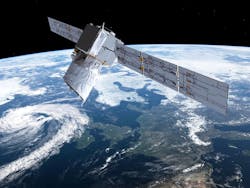NASA mulls space-based lidar Earth-observation instruments to monitor the role of clouds in climate change
GREENBELT, Md. – U.S. space Earth-observation experts are preparing to issue a solicitation later this month for a study to determine the feasibility of using light detection and ranging (lidar) technology to monitor the interaction among aerosols, clouds, atmospheric convection, and precipitation in Earth's upper atmosphere.
Officials of the National Aeronautics and Space Administration (NASA) Goddard Space Flight Center in Greenbelt, Md., issued a presolicitation (80GSFC23LidarStudy) on Monday for the Atmosphere Observing System-Polar (AOS-P) Lidar Instrument Study.
The AOS-P study is part of the larger AOS Lidar Instrument procurement, and will study instrument concepts for the AOS-P mission, and assess future performance, technological maturity, and developmental risk.
The future Atmosphere Observing System will help optimize how NASA examines links among aerosols, clouds, atmospheric convection, and precipitation.
AOS will deliver data for improved weather forecasts, as well as air quality and climate monitoring by increasing the understanding of the vertical structure of Earth's atmosphere with observations from space, skies, and the ground.
AOS will make the first-ever global measurements from space that reveal how ice and water move vertically within clouds; measure how clouds transfer heat; help scientists understand atmospheric aerosols; and develop space-based sensors like lidar and radar.
The intent is to help scientists improve their understanding of climate change and severe weather; how to mitigate natural hazards and fight forest fires; and improve farming practices in the future.
The Lidar Special Study contract will compare potential future Earth-observation instruments, as well as identify necessary hardware, software, and risk mitigation. The intent is to help NASA understand system design viability and risks.
Related: Radiation hardening meets smart satellites
The study will help improve requirements in a future lidar instrument solicitation. NASA does not want system proposals yet. The anticipated release date of the RFP is on or about 20 April 2023 with an anticipated offer due date of 18 May 2023.
Prospective offerors should let NASA know by 18 April 2023 of their intent to submit proposals by email to NASA's [email protected].
More information is online at https://sam.gov/opp/151c774e27c149d493f625a405810fd9/view.
About the Author
John Keller
Editor-in-Chief
John Keller is the Editor-in-Chief, Military & Aerospace Electronics Magazine--provides extensive coverage and analysis of enabling electronics and optoelectronic technologies in military, space and commercial aviation applications. John has been a member of the Military & Aerospace Electronics staff since 1989 and chief editor since 1995.
